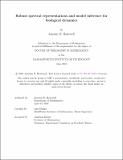Robust spectral representations and model inference for biological dynamics
Author(s)
Hastewell, Alasdair D.
DownloadThesis PDF (18.79Mb)
Advisor
Dunkel, Jörn
Terms of use
Metadata
Show full item recordAbstract
Current developments in automated experimental imaging allow for high-resolution tracking across various scales, from whole animal behavior to single-cell dynamics to spatiotemporal gene expression. Transforming these high-dimensional data into effective low-dimensional models is an essential theoretical challenge to enable the characterization, comparison, and prediction of dynamics both within and across biological systems. Spectral mode representations have been used successfully across physics, from quantum mechanics to fluid dynamics, to compress and model dynamical data. However, their use in analyzing biological systems has yet to become prevalent. Here, we present a set of noise-robust, geometry-aware mathematical tools that enable spectral representations to extract quantitative measurements directly from experimental data. We demonstrate the practical utility of these methods by applying them to the extraction of defects in signaling fields on membranes, the inference of partial differential equations directly from videos of active particle dynamics, and the categorization of emergent patterns in spatiotemporal gene expression during bacterial swarming.
An additional challenge occurs for complex biophysical processes where the underlying dynamics are only partially determined. We wish to use experimental data directly to infer effective dynamical models that elucidate the system's underlying biological and physical mechanisms. Building on spectral mode representations, we construct a generic computational framework for inferring the dynamics of living systems through the evolution of their mode representations. The framework can incorporate prior knowledge about biological and physical constraints. We apply this framework first to single-cell imaging data during zebrafish embryogenesis, demonstrating how our framework can compactly characterize developmental symmetry-breaking and reveal similarities between pan-embryo cell migration and Brownian particles on curved surfaces. Next, we apply the framework to the undulatory locomotion of worms, centipedes, robots, and snakes to distinguish between locomotion behaviors. Finally, we present an extension of the framework to the case of nonlinear dynamics when all relevant degrees of freedom are only partially observed, with applications to neuronal and chemical dynamics.
Date issued
2024-05Department
Massachusetts Institute of Technology. Department of MathematicsPublisher
Massachusetts Institute of Technology